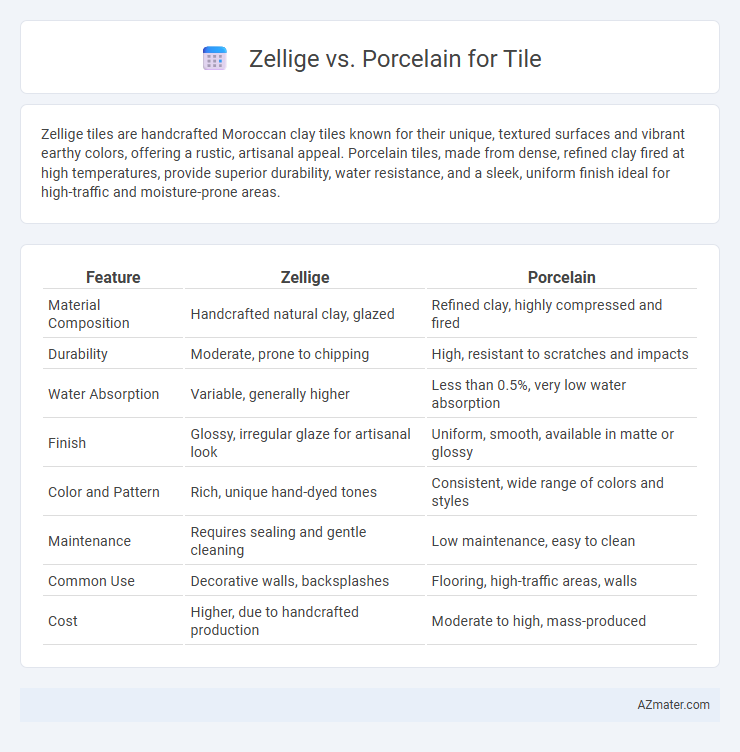Zellige tiles are handcrafted Moroccan clay tiles known for their unique, textured surfaces and vibrant earthy colors, offering a rustic, artisanal appeal. Porcelain tiles, made from dense, refined clay fired at high temperatures, provide superior durability, water resistance, and a sleek, uniform finish ideal for high-traffic and moisture-prone areas.
Table of Comparison
| Feature | Zellige | Porcelain |
|---|---|---|
| Material Composition | Handcrafted natural clay, glazed | Refined clay, highly compressed and fired |
| Durability | Moderate, prone to chipping | High, resistant to scratches and impacts |
| Water Absorption | Variable, generally higher | Less than 0.5%, very low water absorption |
| Finish | Glossy, irregular glaze for artisanal look | Uniform, smooth, available in matte or glossy |
| Color and Pattern | Rich, unique hand-dyed tones | Consistent, wide range of colors and styles |
| Maintenance | Requires sealing and gentle cleaning | Low maintenance, easy to clean |
| Common Use | Decorative walls, backsplashes | Flooring, high-traffic areas, walls |
| Cost | Higher, due to handcrafted production | Moderate to high, mass-produced |
Understanding Zellige and Porcelain Tiles
Zellige tiles, handcrafted from natural clay and glazed with vibrant color variations, offer a unique, artisanal aesthetic characterized by irregular shapes and textures, ideal for creating traditional Moroccan-inspired designs. Porcelain tiles, made from refined clay fired at high temperatures, provide superior durability, water resistance, and uniformity, making them suitable for high-traffic and moisture-prone areas. Understanding the distinct qualities in composition, finish, and performance helps homeowners choose Zellige for decorative, rustic appeal or porcelain for practical, long-lasting flooring solutions.
Key Differences in Material Composition
Zellige tiles are handcrafted from natural clay and fired at low temperatures, resulting in unique, irregular shapes and a porous surface that absorbs moisture. Porcelain tiles are made from a highly refined clay mixture including kaolin, silica, and feldspar, fired at extremely high temperatures to create a dense, hard, and non-porous material. The key difference lies in their composition and firing process, with Zellige offering artisanal texture and moisture absorption, while porcelain provides durability and water resistance.
Aesthetic Appeal: Zellige vs Porcelain
Zellige tiles showcase a handcrafted, Moroccan aesthetic with rich textures and unique glazing that create a warm, artisanal ambiance, ideal for intricate, colorful patterns. Porcelain tiles offer a sleek, modern appearance with uniformity, durability, and a wide range of finishes that mimic natural stone or wood, providing versatile design options. While Zellige emphasizes organic beauty and individuality, Porcelain excels in contemporary elegance and consistency, making the choice dependent on the desired interior style.
Durability and Longevity Comparison
Zellige tiles, handcrafted from natural clay and fired at low temperatures, exhibit unique surface variations but tend to be less durable and more prone to chipping compared to high-density porcelain tiles. Porcelain tiles, made from refined clay and minerals fired at extremely high temperatures, offer superior hardness, resistance to wear, and moisture impermeability, contributing to enhanced longevity in both indoor and outdoor applications. The durability of porcelain makes it ideal for high-traffic areas where long-term performance and minimal maintenance are critical.
Maintenance Requirements for Both Tiles
Zellige tiles require regular sealing and gentle cleaning with non-abrasive products due to their porous, hand-glazed surface that can absorb stains and moisture. Porcelain tiles, known for their dense, non-porous composition, offer low maintenance with simple sweeping and mopping, resisting stains, scratches, and moisture without the need for sealing. Choosing porcelain reduces long-term upkeep, while zellige demands more attentive care to preserve its unique aesthetic and durability.
Water and Stain Resistance Factors
Zellige tiles, made from natural clay and hand-glazed, have a porous surface that makes them less water and stain resistant compared to porcelain tiles. Porcelain tiles, manufactured through high-density firing, offer superior waterproofing and stain resistance, making them ideal for moisture-prone areas like bathrooms and kitchens. The non-porous nature of porcelain reduces absorption rates to below 0.5%, significantly enhancing durability against water and stains compared to Zellige's higher porosity.
Installation Process: Challenges and Tips
Zellige tiles require specialized installation techniques due to their handmade nature and uneven surfaces, demanding skilled artisans to ensure proper alignment and grout application. Porcelain tiles offer easier installation with their uniform size and density, making them suitable for DIY projects using standard tools and adhesives. When installing Zellige, allowing extra time for drying and using flexible grout can prevent cracking, while porcelain benefits from consistent subfloor preparation to enhance adhesion and durability.
Cost Analysis: Zellige vs Porcelain
Zellige tiles typically cost between $30 to $50 per square foot, reflecting their handcrafted nature and unique aesthetic, while porcelain tiles are more budget-friendly, ranging from $3 to $10 per square foot. Installation expenses for Zellige are higher due to the need for skilled labor to handle each tile's irregularities, compared to the more uniform and easier-to-install porcelain tiles. When considering long-term value, porcelain offers durability and lower maintenance costs, whereas Zellige provides a distinctive artisanal appeal at a premium price.
Best Applications for Each Tile Type
Zellige tiles, handcrafted from natural clay and known for their irregular shapes and vibrant glazes, excel in decorative wall applications, backsplashes, and accent areas where artisanal texture and color play are desired. Porcelain tiles, prized for their durability, low porosity, and resistance to wear, are best suited for high-traffic floors, outdoor spaces, and bathrooms that demand water resistance and easy maintenance. Choosing between Zellige and porcelain depends on desired aesthetic impact versus functional performance, with Zellige favoring unique, artistic interiors and porcelain offering robust, versatile surface solutions.
Eco-Friendliness and Sustainability Considerations
Zellige tiles, handcrafted from natural clay and fired at lower temperatures, offer a more sustainable option with minimal chemical treatments and a lower carbon footprint compared to porcelain tiles. Porcelain tiles, though durable and low-maintenance, require high-energy manufacturing processes and extensive water use, impacting their overall eco-friendliness. Choosing zellige contributes to supporting artisanal craftsmanship and reduces environmental impact through renewable materials and traditional production methods.

Infographic: Zellige vs Porcelain for Tile
 azmater.com
azmater.com